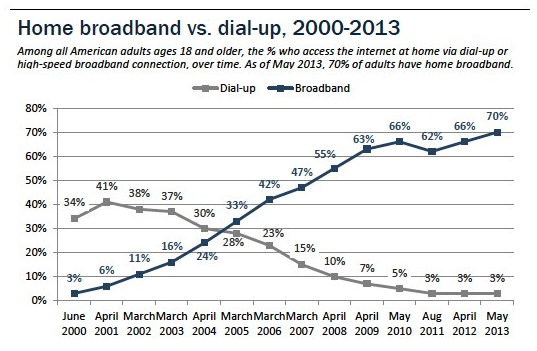1-In-5 American Adults Have Neither Smartphones Nor Home Broadband

70% of U.S. adults now have home broadband, compared to the peak of 41% for dial-up. (Source: Pew)
PEOPLE STILL USE DIAL-UP
As we mentioned in this story on AOL, there are still millions of Americans who continue to pay for dial-up Internet service.
According to new research from the Pew Foundation, around 3% of U.S. adults still choose dial-up over broadband for their home Internet access. Dial-up peaked in 2001, with 41% of homes bleeping and blurping their way onto an incredibly slow-moving information superhighway. By 2005, that number had sunk to 28% and had been overtaken by home broadband. Home dial-up has been holding steady at that 3% since 2011 while broadband hit the 70% mark this year.
THE SMARTPHONE FACTOR
Does having a smartphone also count as having home broadband access? Telecoms promise “lightning fast” speeds and sometimes deliver on service that is hard to distinguish from standard home broadband, but it’s inconsistent. Furthermore, even if one is connected to the Internet via a smartphone, it’s difficult if not impossible to do all the things one could do over home broadband. For that reason, the Pew folks do not yet equate having a smartphone with having home broadband.
However, 10% of U.S. adults have a smartphone and no home broadband Internet connection. Looking at the demographics breakdown of the survey, the smartphone-instead-of-broadband choice is most popular among Hispanics, where 22% of adults in the U.S. have a smartphone but no home broadband. Similarly, black Americans are using smartphones to bridge that broadband gap, with 15% having smartphones but not broadband. By comparison, only 6% of white (non-Hispanic) adults have smartphones without also having broadband.
In terms of economics, 13% of those earning less than $30,000 year say they go the smartphone-only route. 15% of Americans without a high school diploma choose smartphones over broadband, while only 4% of Americans with college degrees make this choice.
Smartphone technology is still relatively new. iPhones have barely been on the market for six years and the first Android-powered phone is only five years old. So far, wireless companies have been rushing to roll out new networks that deliver similar experiences to home broadband, but with mixed results. If these providers can someday match or exceed the speeds offered by home broadband, then we may see the day when a meaningful number of Americans start cutting the Internet cord at home.
Home Broadband 2013 [Pew]
Want more consumer news? Visit our parent organization, Consumer Reports, for the latest on scams, recalls, and other consumer issues.

